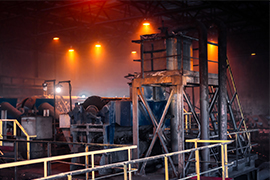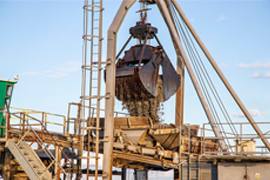What is Carryback Spillage?
Carryback is the material that adheres to the belt conveyor parts after the point of discharge. Material that clings to the belt conveyor parts surface after the discharge point is carried back on the return run, usually dropping off the belt conveyor parts into undesirable locations.
Carryback Spillage is a Problem
The cost of carryback spillage is not always easy to determine. A seemingly small amount of carryback quickly becomes a massive problem for the user. The below example will throw more light on the issue.
How much spillage does a residual layer of just 1/10mm cause?
If we consider a 1000mm wide belt conveyor running at 2 m/sec; the total volume of carryback material carried through in 1 hour is 0.6m3. Assuming that the belt conveyor runs 16 hours a day, 250 days a year, and only 30% of this quantity drops from the lower belt conveyor parts face, it will mean 720 m3 of material on the floor. The quantity represents 43 wagons of 20 tons capacity.
The Cost of Carryback Spillage
- The first and most visible cost of carryback is the cleanup and handling
- The cost of the man-hours for shoveling up material
- The cost of equipment hours of front-end loaders or other heavy equipment used.
- The cost of other maintenance activities that must be delayed while cleaning up the belt conveyor parts line.
- Costly Material Loss: Material lost due to carryback can be expensive. High-priced minerals or chemicals can be lost once they fall to the ground, particularly over mountainous terrain where it is unrecoverable. If the carryback cannot be salvaged, then the cost of producing this lost material raises the costs (and lowers the profits) of the whole operation. If it is recoverable, gathering the carryback and re-introducing it into the system adds handling costs.
Significance: HOSCH eliminates carryback and directs it where the customer wants it to go, saving costly material loss.
- Premature wear of components: Carryback accumulates on belt conveyor components, like idlers and pulleys. Idlers can jam when clogged or buried under material. Once they seize, the wear of the belt conveyor will cut through the idler shell. This leaves a razor-sharp edge that can damage the belt conveyor. Seized idlers and pulleys also increase the friction drag, which dramatically increases the power consumption of the conveyor. Idlers subjected to carryback must be replaced prematurely, in advance of their expected wear life. This increases the costs for equipment, labor costs for installation, and the cost of downtime or lost production to perform the installations.
Significance: HOSCH scrapers eliminate carryback, reducing premature wear of belt conveyor parts.
- Working Conditions: Industrial accidents are costly, both in the health of personnel and in reductions in plant production volume. The average cost of a fatality is increasing every day. This figure includes the costs of medical expenses, worker compensation, accident investigation, loss of family income, and lost production value. Roughly one-half of the accidents that occur around belt conveyors in mines are attributable to cleanup and repairs necessitated by carryback, such as when workers become exposed to hazardous pinch points as they perform hand labor to clean material from around the moving belt conveyor.
Significance: HOSCH scrapers eliminate carryback, which significantly reduces safety hazards in the work environment.
- Mistracking of Conveyor Belt: Material accumulations on idlers and pulleys may lead to mistracking, as the roller becomes nonconcentric. A pulley with material build-up acts like a crowned pulley; the belt conveyor will try to center itself over the crown, and if the crown is not at the center of the pulley, it can cause the belt conveyor to mistrack. If the belt conveyor runs off the pulley, it can make contact with the conveyor structure. If this isn't noticed right away, great lengths of valuable belting can be destroyed, and the conveyor structure can be damaged. The build-up of carryback can also create unequal tension on the belt conveyor, which reduces belt conveyor life (particularly steel cord belts).
Significance: HOSCH scrapers eliminate carryback, which is one cause of mistracking.
- Diminished Quality: Carryback is a major deterrent to employee efforts to maintain high plant quality. Carryback provides a very visible example of the sloppy practices that corporate quality programs are working to eliminate. If employees see that a portion of the operation, i.e. a conveyor transfer point, is operating inefficiently, making a mess, and contaminating the remainder of the plant with carryback, they will get used to accepting less-than-perfect performance. They may adopt a negative attitude, becoming lax or sloppy in the performance of their responsibilities.
Significance: HOSCH scrapers eliminate carryback, which helps give employees pride in their clean plant.
While many decision-makers realize the need to solve their carryback problems, they do not realize how expensive carryback is. So they use relatively lower efficient belt scrapers. These alternatives may initially be less expensive; however, vastly superior cleaning makes HOSCH a much better investment.



